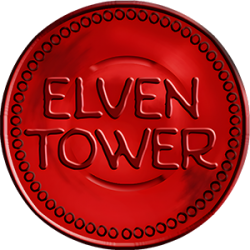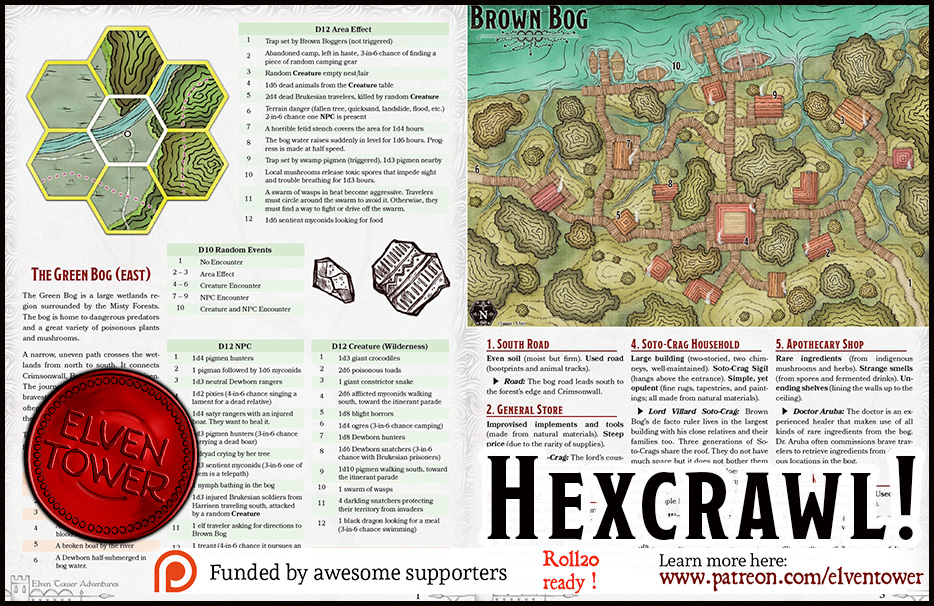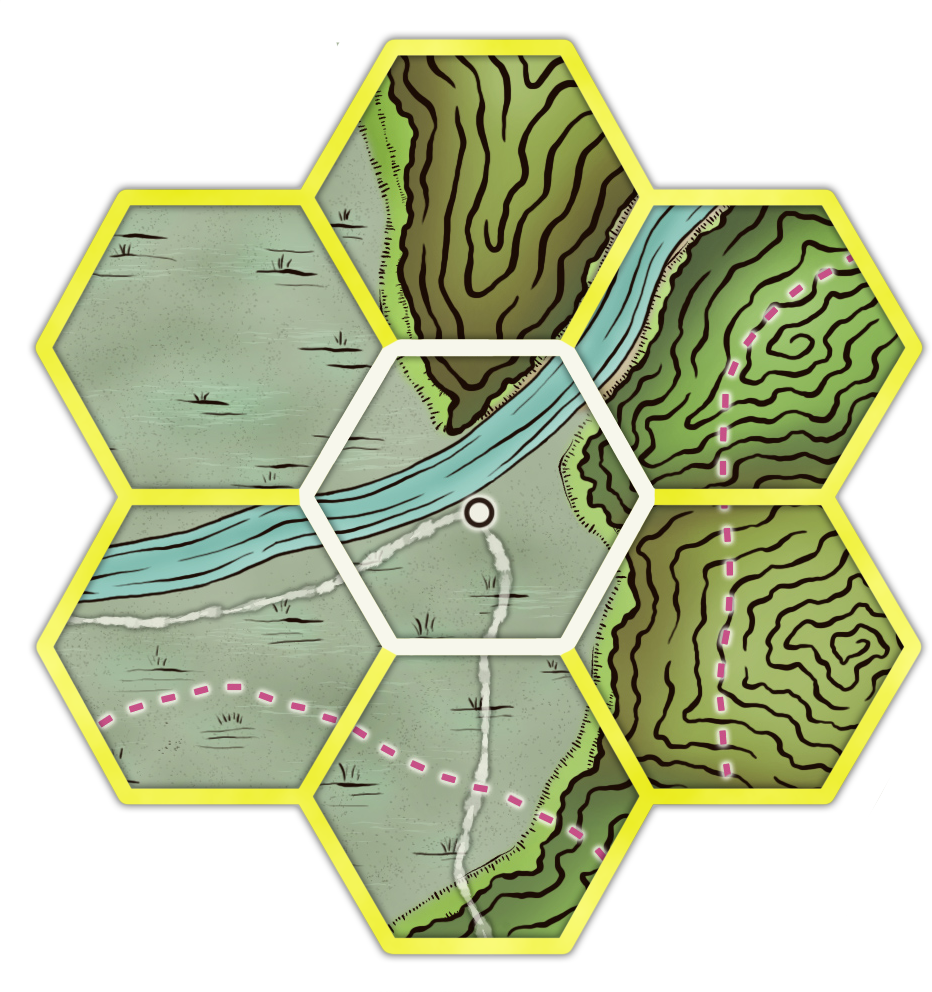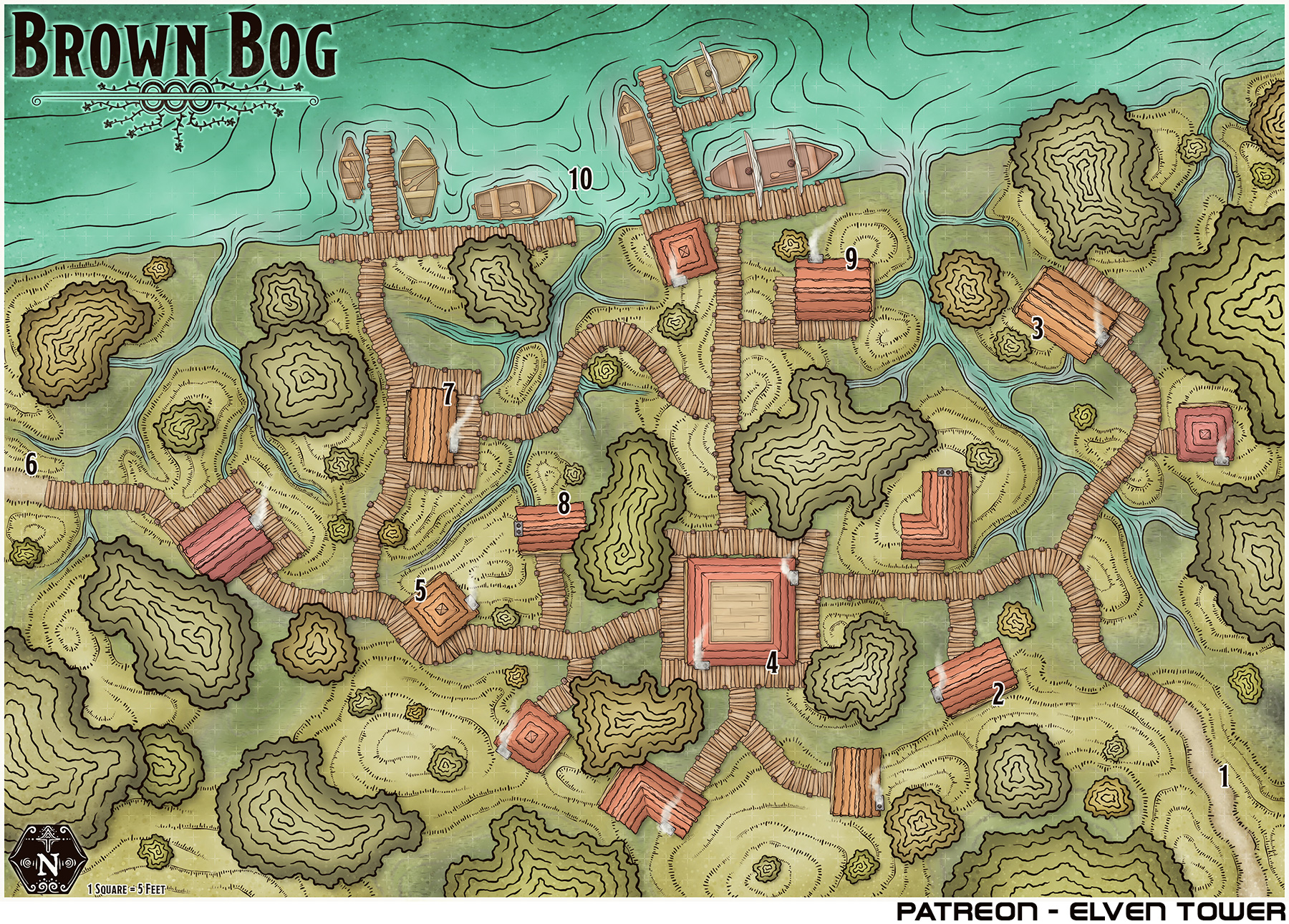You can buy the Brukesian Duchy 90-page OSR PDF here
You can get the FREE Brukesian Duchy preview here
This adventure is part of the Brukesian Duchy Hexcrawl. Find more about it here!
Lord Villard Soto-Crag settled the town Brown Bog by the eastern reaches of the Green Bog. The day he, his close relatives, and some loyal retainers moved to the bog against Duke Crane’s orders, most people in Crimsonwall believed they would not last a year before returning to seek refuge behind the capital’s tall walls. The nobles were amused by the Soto-Crag’s stupidity. Alas, it has been fifteen years and the swamp-lovers continue to thrive in the dangerous Green Bog. Better yet, more people join them as time passes and their community grows.
Town’s History
Before Brown Bog, there had never been a human settlement in the Green Bog. The wetlands within the Misty Forests are home to aggressive territorial monsters and the land is uneven and difficult to build on. Explorers and brave pathfinders found a way through the bog and charted a way to travel from Crimsonwall to Harrisen. The path roughly follows the Dew River upstream. Regardless, traversing the bog is a risky proposition.
Fifteen years ago, the Soto-Crag family lived in Crimsonwall and enjoyed the luxuries of the capital. The family patriarch was Lord Villard Soto-Crag. Villard is a simple man with a soft side for walking in the wilderness at night and hunting savage creatures for their furs and food. He was known for his hunting trophies.
One day, he claimed he heard the call of the wild. It allured him to abandon all wealth and join nature in the bog. When he voiced this sentiment, some people thought he’d fallen under the itinerant parade’s charm of madness.
Nothing convinced Villard to stay in the capital. Some relatives pleaded and demanded he stay and Duke Crane ordered him to remain in the capital. Still, Lord Villard Soto-Crag settled his affairs and left with a small group of relatives and loyal friends who believed him.
It was soon understood that they were not afflicted with the itinerant parade’s fever. Brown Boggers live in communion with the wetlands and lead simple and prosperous lives. Predators and Dewborn leave them be. The indifference is interpreted as acceptance, by the locals.
|
D8 Random Encounters |
|
|
1 |
1d3 crocodiles sneak into town and endanger the locals’ safety |
|
2 |
2d4 myconids arrive at Brown Bog (2-in-6 chance they are sentient) |
|
3 |
1 swarm of wasps comes too close to Brown Bog |
|
4 |
2 Dewborn rangers visit town and plan to stay the night |
|
5 |
1 Brown Bog person requests help retrieving a lost back pack in the bog |
|
6 |
1 Brown Bog person requests escorting north to Harrisen, it is dangerous |
|
7 |
1d3 Brown Bog kids steal something and run to the bog |
|
8 |
2d4 pigmen arrive at Brown Bog and claim to own the land |
|
D8 Random Events |
|
|
1 |
A gust of wind blows suddenly and extinguishes exposed light sources |
|
2 |
Dense mist covers the bog for 1d4 hours, the floor is not visible |
|
3 |
1d6 sentient myconids arrive at Brown Bog to sell remedies |
|
4 |
Unnatural cold fills the bog for 1d6 hours. The heroes’ breathing makes mist in front of them |
|
5 |
A black dragon flies high above Brown Bog and roars like a thunder |
|
6 |
The growl of darklings can be heard beyond the town’s borders |
|
7 |
Pigmen oinks echo in the darkness |
|
8 |
4d20 bats fly by Brown Bog and fill the air with their screeches |
General Features
Brown Bog is a small community located by the eastern border of the Green Bog. It consists of thirteen raised buildings connected by uneven wooden bridges. Every structure in Brown Bog stands ten to fifteen feet from the swampy floor below. Unless otherwise noted:
Low-light life (the town is half dark even during the day). Moist stench (smell of stagnant water). Hungry mosquitoes (larger than usual and persistent). Wooden buildings (one-storied, stone chimneys, and thatched roof).
1. South Road
Even soil (moist but firm). Used road (bootprints and animal tracks).
- Road: The bog road leads south to the forest’s edge and Crimsonwall.
2. General Store
Improvised implements and tools (made from natural materials). Steep price (due to the rarity of supplies).
- Harold Soto-Crag: The lord’s cousin makes a living selling and bartering to travelers and sailor merchants.
3. Ale House
Available room (small and simple). Insipid ale (made from sub-par ingredients). Packed and warm (locals mostly).
- Diana Soto-Crag: The lord’s sister owns the ale house and hosts locals most nights. She visits Harrisen twice a year.
4. Soto-Crag Household
Large building (two-storied, two chimneys, well-maintained). Soto-Crag Sigil (hangs above the entrance). Simple, yet opulent (fine rugs, tapestries, and paintings; all made from natural materials).
- Lord Villard Soto-Crag: Brown Bog’s de facto ruler lives in the largest building with his close relatives and their families too. Three generations of Soto-Crags share the roof. They do not have much space but it does not bother them in the least. Lord Soto-Crag does not look noble-like at all. He wears simple clothing and animal furs when it gets cold. He lives a simple life without wealth.
- The Way of the Bog: Lord Soto-Crag and the community in Brown Bog follow a strict code of life that prevents them from abusing nature in the Green Bog. They live in harmony and only take what they need to survive.
5. Apothecary Shop
Rare ingredients (from indigenous mushrooms and herbs). Strange smells (from spores and fermented drinks). Unending shelves (lining the walls up to the ceiling).
- Doctor Aruba: The doctor is an experienced healer that makes use of all kinds of rare ingredients from the bog. Dr. Aruba often commissions brave travelers to retrieve ingredients from dangerous locations in the bog.
6. West Road
Even soil (moist but firm). Used road (bootprints and animal tracks).
- Road: The bog road curves north and follows the Dew River upstream to the northern edge of the Green Bog. It then continues on a two-day-walk north toward Harrisen.
7. June’s House
Hunting trophies (hanging from most walls in the house). Triple bunk beds (enough space for eight people).
- Hunter June: The hunter lives here with his wife and six children. June and his two eldest children are the best hunters in Brown Bog. They often go hunting in company of Lord Villard Soto-Crag.
8. Joseph’s Tannery
Disgusting stench (it mixes with the swampy smell). Drying leather racks (arranged around the house).
- Joseph: The tanner’s work is well appreciated in Brown Bog. Good leather has plenty of uses in a town that lacks metallurgy. Joseph buys exotic pelts and furs for a fair price.
9. Mrs. Hannah’s Home
Available room (well-furnished, belonged to her late son). Seamstress Tools (scattered around the house).
- Mrs. Hannah Soto-Crag: This woman lives alone. Her husband and son lost their lives north close to Harrisen. They were ambushed by Dewborn rangers and taken captive. They were never seen again. Mrs. Hannah is a seamstress. She makes clothing articles and barters them to other townsfolk or travelers. She is eager to lease her spare room to travelers for a few coins.
- The Sword: Mrs. Hannah claims that her late husband carried a magical sword that was passed down through generations. The sword featured the Soto-Crag family sigil in the guard and pommel. She wishes to retrieve this heirloom.
10. Brown Wharf
Small vessels (mostly fishing oar boats). Merchant Barges (with large cargo holds and sails).
- Barter Market: Merchant barges from Harrisen and Barrowstream often stop at Brown Bog to barter. The locals do not have much money but their bog ingredients, spices, implements, and remedies are valuable. The sailors stop at the wharf and barter from their ship decks.
- Passage: Travelers can request to board a vessel to travel faster. Passage to Crimsonwall takes 4 days and has a cost of 10 gp per passenger. Passage north to Harrisen takes 6 days because the journey upstream is significantly slower. It costs 15 gp per passenger. Travelers may also barter their own presence as guards to reduce the cost.







